The interplays between Crimean-Congo hemorrhagic fever virus (CCHFV) M segment-encoded accessory proteins and structural proteins promote virus assembly and infectivity
- PMID: 32956404
- PMCID: PMC7529341
- DOI: 10.1371/journal.ppat.1008850
The interplays between Crimean-Congo hemorrhagic fever virus (CCHFV) M segment-encoded accessory proteins and structural proteins promote virus assembly and infectivity
Abstract
Crimean-Congo hemorrhagic fever virus (CCHFV) is a tick-borne orthonairovirus that has become a serious threat to the public health. CCHFV has a single-stranded, tripartite RNA genome composed of L, M, and S segments. Cleavage of the M polyprotein precursor generates the two envelope glycoproteins (GPs) as well as three secreted nonstructural proteins GP38 and GP85 or GP160, representing GP38 only or GP38 linked to a mucin-like protein (MLD), and a double-membrane-spanning protein called NSm. Here, we examined the relevance of each M-segment non-structural proteins in virus assembly, egress and infectivity using a well-established CCHFV virus-like-particle system (tc-VLP). Deletion of MLD protein had no impact on infectivity although it reduced by 60% incorporation of GPs into particles. Additional deletion of GP38 abolished production of infectious tc-VLPs. The loss of infectivity was associated with impaired Gc maturation and exclusion from the Golgi, showing that Gn is not sufficient to target CCHFV GPs to the site of assembly. Consistent with this, efficient complementation was achieved in cells expressing MLD-GP38 in trans with increased levels of preGc to Gc conversion, co-targeting to the Golgi, resulting in particle incorporation and restored infectivity. Contrastingly, a MLD-GP38 variant retained in the ER allowed preGc cleavage but failed to rescue miss-localization or infectivity. NSm deletion, conversely, did not affect trafficking of Gc but interfered with Gc processing, particle formation and secretion. NSm expression affected N-glycosylation of different viral proteins most likely due to increased speed of trafficking through the secretory pathway. This highlights a potential role of NSm in overcoming Golgi retention and facilitating CCHFV egress. Thus, deletions of GP38 or NSm demonstrate their important role on CCHFV particle production and infectivity. GP85 is an essential viral factor for preGc cleavage, trafficking and Gc incorporation into particles, whereas NSm protein is involved in CCHFV assembly and virion secretion.
Conflict of interest statement
The authors have declared that no competing interests exist.
Figures
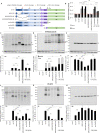
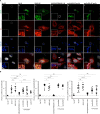
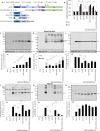
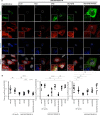
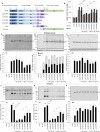


Similar articles
-
Recovery of Recombinant Crimean Congo Hemorrhagic Fever Virus Reveals a Function for Non-structural Glycoproteins Cleavage by Furin.PLoS Pathog. 2015 May 1;11(5):e1004879. doi: 10.1371/journal.ppat.1004879. eCollection 2015 May. PLoS Pathog. 2015. PMID: 25933376 Free PMC article.
-
Crimean-Congo hemorrhagic fever virus glycoprotein processing by the endoprotease SKI-1/S1P is critical for virus infectivity.J Virol. 2007 Dec;81(23):13271-6. doi: 10.1128/JVI.01647-07. Epub 2007 Sep 26. J Virol. 2007. PMID: 17898072 Free PMC article.
-
The Crimean-Congo Hemorrhagic Fever Virus NSm Protein is Dispensable for Growth In Vitro and Disease in Ifnar-/- Mice.Microorganisms. 2020 May 21;8(5):775. doi: 10.3390/microorganisms8050775. Microorganisms. 2020. PMID: 32455700 Free PMC article.
-
Crimean-Congo Hemorrhagic Fever: Tick-Host-Virus Interactions.Front Cell Infect Microbiol. 2017 May 26;7:213. doi: 10.3389/fcimb.2017.00213. eCollection 2017. Front Cell Infect Microbiol. 2017. PMID: 28603698 Free PMC article. Review.
-
Crimean-Congo Hemorrhagic Fever.Lab Med. 2015 Summer;46(3):180-9. doi: 10.1309/LMN1P2FRZ7BKZSCO. Lab Med. 2015. PMID: 26199256 Review.
Cited by
-
Cell-Free Synthesis of Bunyavirales Proteins in View of Their Structural Characterization by Nuclear Magnetic Resonance.Methods Mol Biol. 2024;2824:105-120. doi: 10.1007/978-1-0716-3926-9_8. Methods Mol Biol. 2024. PMID: 39039409
-
Structural basis of synergistic neutralization of Crimean-Congo hemorrhagic fever virus by human antibodies.Science. 2022 Jan 7;375(6576):104-109. doi: 10.1126/science.abl6502. Epub 2021 Nov 18. Science. 2022. PMID: 34793197 Free PMC article.
-
The low-density lipoprotein receptor and apolipoprotein E associated with CCHFV particles mediate CCHFV entry into cells.Nat Commun. 2024 May 28;15(1):4542. doi: 10.1038/s41467-024-48989-5. Nat Commun. 2024. PMID: 38806525 Free PMC article.
-
Development of a Novel Multi-Epitope Vaccine Against Crimean-Congo Hemorrhagic Fever Virus: An Integrated Reverse Vaccinology, Vaccine Informatics and Biophysics Approach.Front Immunol. 2021 Jun 16;12:669812. doi: 10.3389/fimmu.2021.669812. eCollection 2021. Front Immunol. 2021. PMID: 34220816 Free PMC article.
-
Recent Advances in Crimean-Congo Hemorrhagic Fever Virus Detection, Treatment, and Vaccination: Overview of Current Status and Challenges.Biol Proced Online. 2024 Jun 26;26(1):20. doi: 10.1186/s12575-024-00244-3. Biol Proced Online. 2024. PMID: 38926669 Free PMC article. Review.
References
-
- Walker PJ, Widen SG, Firth C, Blasdell KR, Wood TG, Travassos da Rosa AP, et al. Genomic Characterization of Yogue, Kasokero, Issyk-Kul, Keterah, Gossas, and Thiafora Viruses: Nairoviruses Naturally Infecting Bats, Shrews, and Ticks. Am J Trop Med Hyg. 2015;93(5):1041–51. 10.4269/ajtmh.15-0344 - DOI - PMC - PubMed
-
- Gargili A, Estrada-Pena A, Spengler JR, Lukashev A, Nuttall PA, Bente DA. The role of ticks in the maintenance and transmission of Crimean-Congo hemorrhagic fever virus: A review of published field and laboratory studies. Antiviral Res. 2017;144:93–119. 10.1016/j.antiviral.2017.05.010 - DOI - PMC - PubMed
Publication types
MeSH terms
Substances
Grants and funding
LinkOut - more resources
Full Text Sources
Other Literature Sources
Miscellaneous

